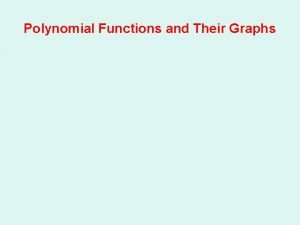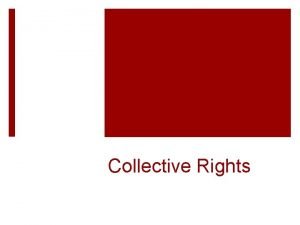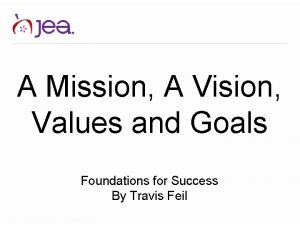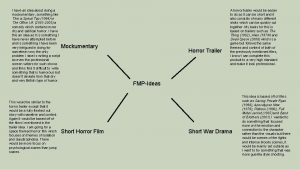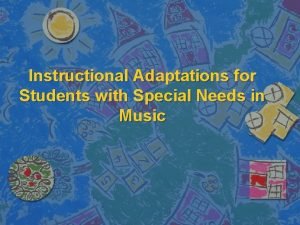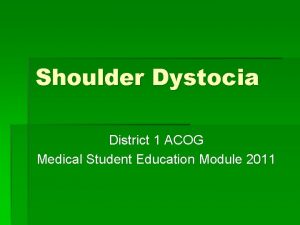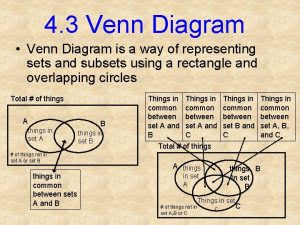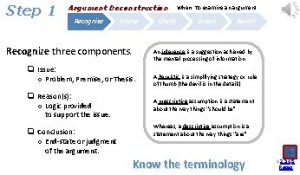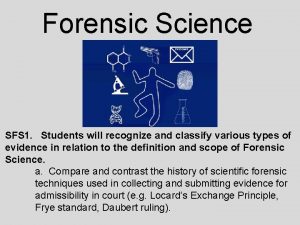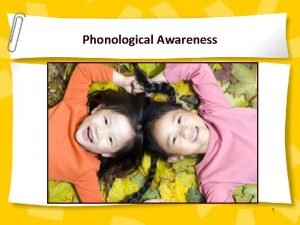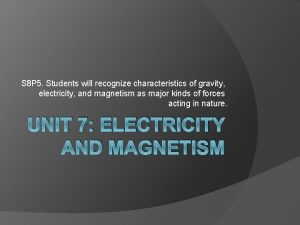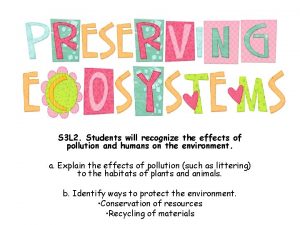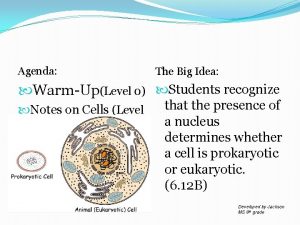S 7 L 3 Students will recognize how












































- Slides: 44

S 7 L 3. Students will recognize how biological traits are passed on to successive generations. a. Explain the role of genes and chromosomes in the process of inheriting a specific trait. 2/22/16 Agenda: Heredity and Genetics Intro Learning Target: I know that heredity passes inherited traits to offspring , because … Success Criteria: I can describe the factors that control the inheritance of traits in organisms. Warm Up: 1. List at least 3 different characteristics that you possess. This may include skills or physical features. 2. For each characteristic listed, describe where it came from.

Traits • Dog breeders select certain traits to produce dogs for different purposes. What traits do you think are each of these dogs might have been was breed for?

Heredity • Ancient dog breeders thought that the traits inherited by a dog were a blend of those from the mother and father. • An organism’s heredity is the set of traits it receives from its parents. • Today, we know that heredity is not so simple.

Reminder:

Genetic Material ~stop @ 1: 19 Brainpop Genetics https: //www. brainpop. com/health/geneticsgrowthanddevelopment/genetics/ minutes Watch and listen to answer the following: 1. What is heredity? 2. What is the relationship between DNA and chromosomes? 3. Why are your chromosomes arranged in pairs? 4. How does DNA vary in individuals?

Genetic Material 1. What is heredity? A. A kind of genetic disorder B. The way that DNA divides C. A trait you inherit from your parents D. The passing down of traits from parents to children 2. What is the relationship between DNA and chromosomes? A. Chromosomes are made out of DNA B. DNA is made out of chromosomes C. DNA and chromosomes are the same thing D. DNA forces chromosomes to mutate

Genetic Material 3. Why are your chromosomes arranged in pairs? A. Scientists aren't sure B. Because you get one from your mother, and one from your father C. Because pairs are able to divide more easily D. Because DNA has a double helix structure 4. Which of the following statements is true? A. Your set of DNA is the same as your siblings' B. Your set of DNA is the same as your mother's C. Your set of DNA is the same as your father's D. Your set of DNA is unique to you

Study Jams: Heredity http: //studyjams. scholastic. com/studyjams/science/human-body/heredity. htm

5. Genetics • Genetics is the study of heredity. • A monk (priest) named Gregor Mendel was one of the first to experiment with heredity. • He is often called the “Father of Genetics. ”

6. The Priest and the Pea • Mendel carefully studied pea plants in the monastery garden. • He noticed peas had 2 forms of a trait. – Flower color was purple or – Seed shape was – Seed color was – Pod color was green or or or green


7. The Priest and the Pea • Mendel noticed that a trait from the parent pea plant did not always show up in the offspring or F 1 (1 st generation or filial). • Mendel wanted to find out why traits disappeared and then appeared again.

8. True Breeding Plants • For his experiments, Mendel was careful to start out with purebred parent plants. • A purebred plant with purple flowers will only produce plants with purple flowers.

9. First Generation • When Mendel crossed purebred, purple-flowered plants with purebred, white-flowered plants, the first generation produced all purple-flowered plants! • Mendel got similar results for the other traits. X = crossed with

10. Second Generation • When the purple-flowered plants of the offspring self -pollinated, white flowers reappeared in the second generation. • Mendel was careful. • How could this happen?


11. Mendel’s Conclusions • From his results, Mendel proved that all traits do not blend in a 50/50 ratio. • Pea plants exhibited one trait over another in a ratio of about 3 to 1. • Mendel concluded that pea traits like flower color were determined by separate units. • Today, we call those units genes.

12. Dominant and Recessive Alleles • We call the different forms of the same trait alleles. • Mendel showed us that the dominant allele (purple flower) appears in peas more often and seems to “hide” the other form (white flower). • A recessive allele is the form of a gene that gets hidden if the dominant allele is present.

Dominant and Recessive Alleles • If both alleles for flower color get passed to the offspring, then the dominant allele that causes purple flowers hides the recessive allele. • No white flowers show up in the next generation.

S 7 L 3. Students will recognize how biological traits are passed on to successive generations. a. Explain the role of genes and chromosomes in the process of inheriting a specific trait. 2/23/16 Agenda: Genetics and Probability Learning Target: I know how biological traits are passed on to successive generations, because … Success Criteria: I can use a Punnett square to predict the probable genotypes of the offspring. Warm Up: See next slide.

Use the chart above to answer the following review questions: 1. According to the table, if a purebred tall pea plant is crossed with a purebred short pea plant, what will the phenotype (physical appearance) of the offspring be? 2. How can this be predicted? How do you know? 3. What alleles would result in a yellow pod? What alleles must the offspring have?

Mendel & Punnett Squares on Brainpop Watch the following clip and answer the following questions: 1. What is a Punnett Square used for in genetics? 2. How are dominant alleles represented? 3. How are recessive alleles represented? Day 2: Note start video clip @ 51 sec. s • https: //www. brainpop. com/health/geneticsgrowthanddevelopment/heredity/

13. Genotype • Mendel used letters to show the different forms of a gene were passed to the next generation. • Mendel discovered that a pea plant with purple flowers could have a genotype of either PP or Pp. • A pea plant with white flowers could only have a genotype of pp. • An organism’s genotype shows the alleles of a gene it contains. • Think, “Geno = Genes. ”

14. Phenotype • An organism’s phenotype is the form of a trait that is visible. • Think, “ Pheno = Physical. ” • For flower color, a pea plant can show a phenotype of purple or white flowers.


- Probability and Heredity 15. Phenotypes and Genotypes • An organism’s phenotype is its physical appearance, or visible traits, and an organism’s genotype is its genetic makeup, or allele combinations.

Describe the factors that control the inheritance of traits in organisms by completing the graphic organizer.


- Probability and Heredity 16. Phenotypes and Genotypes • An organism’s phenotype is its physical appearance, or visible traits, and an organism’s genotype is its genetic makeup, or allele combinations. An organism that has two identical alleles for a trait is said to be homozygous. An organism that has two different alleles for a trait is heterozygous for that trait.

- Probability and Heredity 17. Phenotypes and Genotypes • What phenotype/s are possible when you have an organism with homozygous alleles? • What phenotype/s are possible when you have an organism with heterozygous alleles?

- Probability and Heredity • What are the genotypes of these guinea pig parents? • What are the phenotypes of these guinea pig parents? • Are the parents heterozygous or homozygous? • What about the offspring?

18. Predicting Genotypes and Phenotypes • You can predict the possible genotypes and phenotypes of offspring if you know the genotypes of the parents. • A Punnett square shows all of the possible combinations of alleles from the parents.

- Probability and Heredity 19. A Punnett Square • The diagrams show to make a Punnett square. In this cross, both parents are heterozygous for the trait of seed shape. R represents the dominant round allele, and r represents the recessive wrinkled allele.


Punnett Square Practice • Now practice predicting offspring in different crosses using a Punnett Square.

Closing: • How does a Punnett Square help to predict the probable genotypes of the offspring?

- Probability and Heredity Probability and Genetics • In a genetic cross, the allele that each parent will pass on to its offspring is based on probability.

Punnett squares and probability • Probability is the mathematical chance that an event will occur. • Probability can be expressed as a fraction, a ratio, or a percentage.

- Probability and Heredity Codominance • In codominance, the alleles are neither dominant nor recessive. As a result, both alleles are expressed in the offspring.

Reviewing Vocabulary Key Terms heredity trait Definitions a. the passing of traits from parents to offspring genetics b. an organism with two different alleles for a trait fertilization c. factors that control traits purebred d. physical characteristics of organisms gene alleles e. an allele whose trait always shows up in the organism dominant allele f. the different forms of a gene recessive allele g. the scientific study of heredity hybrid h. an allele whose trait is masked in the presence of a dominant allele

- Probability and Heredity Building Vocabulary • Use all the information you have learned to write a definition of each Key Term in your own words. Key Terms: Examples: F 1 Probability is a number that describes how likely it is that an event will occur. Punnett square A Punnett square is a chart that shows all the possible combinations of alleles that can result from a genetic cross. phenotype An organism’s phenotype is its physical appearance, or visible traits. genotype An organism’s genotype is its genetic makeup, or allele combinations.

Building Vocabulary • Use all the information you have learned to write a definition of each Key Term in your own words. Key Terms: probability Examples: Probability is a number that describes how likely it is that an event will occur. heterozygous An organisms that has two different alleles for a trait is heterozygous for that trait. codominance In codominance, the alleles are neither dominant nor recessive.

Building Vocabulary • Use all the information you have learned to write a definition of each Key Term in your own words. Key Terms: Examples: homozygous An organisms that has two identical alleles for a trait is said to be homozygous. heterozygous An organisms that has two different alleles for a trait is heterozygous for that trait. codominance In codominance, the alleles are neither dominant nor recessive.

 Rizal salute to luna and hidalgo
Rizal salute to luna and hidalgo Graphing polynomial functions
Graphing polynomial functions Social conflict criminology
Social conflict criminology 1997 code of ethics for professional teachers
1997 code of ethics for professional teachers Skill 2 recognize the organization of ideas
Skill 2 recognize the organization of ideas What does beowulf do before he swims back to land
What does beowulf do before he swims back to land Refusing to recognize an emotion
Refusing to recognize an emotion Chronic hyperplastic candidiasis
Chronic hyperplastic candidiasis Objectives of an operating system
Objectives of an operating system Israel palestine
Israel palestine Canadian collective rights
Canadian collective rights Lars didn't recognize patrick logan because
Lars didn't recognize patrick logan because 1. from where does kat recognize the girl with red hair?
1. from where does kat recognize the girl with red hair? When a material is useful and harmful?
When a material is useful and harmful? Entrepreneurship chapter 1
Entrepreneurship chapter 1 Psychology
Psychology The organization of ideas
The organization of ideas How to write a peer review for college
How to write a peer review for college Descriptive vs evaluative feedback
Descriptive vs evaluative feedback Bullying skits
Bullying skits Good morning, students
Good morning, students Mission statement examples for students
Mission statement examples for students Objective for stress management
Objective for stress management Students reflection on their learning sample
Students reflection on their learning sample Ben poon
Ben poon Good morning students how are you today
Good morning students how are you today Mockumentary ideas
Mockumentary ideas Unrhymed poem from japan
Unrhymed poem from japan Never work harder than your students
Never work harder than your students Teaching web design to high school students
Teaching web design to high school students Elevator pitch for a product
Elevator pitch for a product Eustress
Eustress Quizstar 4 students
Quizstar 4 students My pepole doc
My pepole doc Instructional adaptations for special needs students
Instructional adaptations for special needs students Gifted and talented learners in the philippines
Gifted and talented learners in the philippines Students today leaders tomorrow
Students today leaders tomorrow Good afternoon dear students en español
Good afternoon dear students en español Coworking for students
Coworking for students Research problem statement and objectives examples
Research problem statement and objectives examples Shoulder dystocia helper
Shoulder dystocia helper What are your limitations as a student
What are your limitations as a student Bill examples for students
Bill examples for students What students do
What students do Pengertian diagram venn
Pengertian diagram venn

